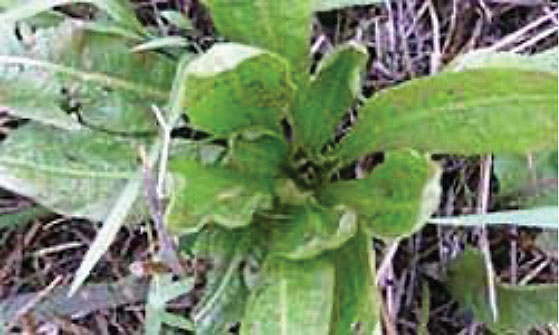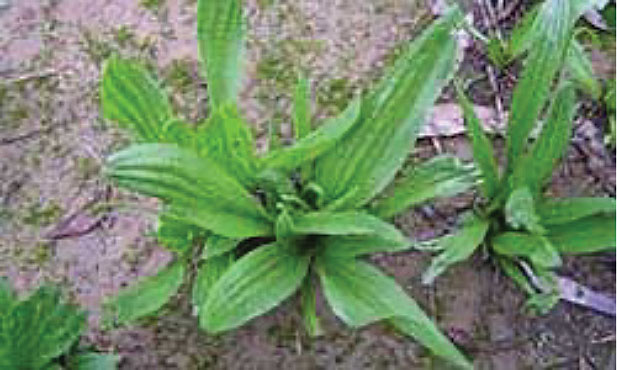Specialist forages for lamb finishing
This article has been adapted by Jane Court, from an information sheet produced by Viv Burnett and Dr Eric Ponnampalam (Agriculture Victoria)
A variety of forage options are available, which can be useful options in a pasture renovation program and/or for providing quality feed for growing out or finishing stock. The main benefits of using forage crop options for finishing lambs is the provision of some high-quality feed at a time when pastures may be limiting. This article looks at some of the more specialist forages to optimise lamb growth and production.
Chicory (Chicorium intybus)
Chicory is a perennial herb highly suited to lamb finishing. It requires a minimum annual rainfall of 600 mm and will tolerate low soil pH. It has high nutritive value, with Crude Protein (CP) of 14–24 per cent, 70–80 per cent digestibility and Metabolisable Energy (ME) of 10.3–12.1 MJ/kg DM in the leaves. Chicory is usually sown in autumn and has its main growth period in spring and summer. It is a short-lived perennial and should persist for three to four years, although this can be extended with managed reseeding. It has a high mineral content and is generally sown in a mix, although this reduces chemical weed control options as broadleaf herbicides cannot be used (EverGraze). Soil moisture data from EverGraze indicates it dries the soil to three metres, which is comparable to lucerne. Chicory responds well to summer rain events.
Table 1 shows the range in pasture growth rates, production, and feed quality (as digestibility) for lucerne and chicory pastures at the EverGraze Hamilton Proof Site between 2007–2010 in summer and autumn.
Lambs grazing chicory can have growth rates of 190–370 g/day compared with ryegrass at 160–230 g/day or lucerne at 170–300 g/day (Chicory factsheet, NSW DPI 2011). This may be important in areas where summer rainfall is unreliable and faster turn-off of lambs is required. In a lamb finishing experiment in NSW, lambs were finished on either lucerne based pasture or on chicory swards. Lambs grazing chicory grew faster than lambs grazing lucerne in three out of five groups, with average growth rates of between 172–312 g/day (Holst et al 1998). In the Central Tablelands region of NSW, chicory produced lamb growth rates of 125 g/day during finishing, allowing greater opportunities for producers in an environment where summer rainfall is unreliable (Holst et al 2006).

Plantain (Plantago lanceolata)
Plantain is a perennial herb requiring 550–650 mm annual rainfall. It is adapted to a wide pH range (pH CaCl2 4.2–7.8) and will tolerate low fertility soils and drought. Plantain can have a nutritive value of 13.8 per cent CP in the vegetative stage, ME of 10 MJ/kg DM with dry matter digestibility of 72 per cent (leaf) and 59 per cent (stems). It has lower palatability compared with other forage species. Plantain has its main growing season in winter and spring, with some opportunistic growth in summer. It has a relatively high concentration of magnesium (Mg) and calcium (Ca) which may assist in reducing the risk of grass tetany in mixed pastures. Plantain can be included in pasture mixes containing grasses and legumes but needs careful management to ensure it isn’t smothered by other species.
Lamb performance on pure plantain has generally been poorer than on chicory and brassicas but better than perennial ryegrass in the summer/autumn.

Forage brassicas and summer canola
Forage brassicas (particularly forage rape species) are a popular option for providing quality feed in summer/autumn. They are suited to a range of soil types of varying fertility and have the capacity to produce a good quantity of feed with high nutritive value over an extended period, when winter active grass-based pastures are generally declining in quantity and quality. They can support good growth rates for lambs; however, it can take 2–3 weeks for animals to adapt before feed consumption and growth rates increase. Some results of lamb performance with other forages are provided below.

Spring sown canola
Spring sowing of winter-type canola varieties can be used as replacement for the spring sowing of a brassica/forage rape crop for sheep production and produce similar levels of dry matter to traditional brassica forages. They can produce three to four tonnes of DM/ha of feed with high nutritive value (approximately 12 MJ /kg DM and 14 per cent CP) over summer and autumn and into winter. If adequate growth occurs the crop can be grazed a number of times until the following winter, when it can then be locked up for seed/oil production. This system should be considered in regions with longer growing seasons suitable for spring sowing and where there is a reasonable incidence of summer rainfall events. Studies at Agriculture Victoria Hamilton have shown lamb growth rates ranged from 100 to 240 g/day once the lambs adapted to canola.
All winter-type canola varieties can be used for spring sowing as they have a vernalisation requirement and a later flowering date. Spring-type canola varieties are not suitable for spring sowing, as they will try to flower early and reach maturity too soon.
Forage comparisons
Field experiments at Hamilton Victoria, in 2014 and 2016 tested seven forage treatments – canola (two different cultivars), forage brassica, lucerne, chicory, plantain and perennial ryegrass. Herbage mass and nutritive characteristics of the canola varieties were similar to forage brassica. Herbage mass in March 2014 was 3.35–3.64 t DM/ha for brassicas; 1.05–1.37 t DM/ha for perennial ryegrass, plantain and chicory; and 2.94 t DM/ha for lucerne. In March 2016, herbage mass was 1.86–2.05 t DM/ha for brassicas and 2.14–2.49 for the other forage treatments. Brassicas had higher ME concentrations and lower neutral detergent fibre (NDF) concentrations on most sampling dates compared to chicory, plantain, lucerne and perennial ryegrass. The crude protein concentration of the brassica treatments was not different from that of the other forage treatments.
Ewe lamb growth rates and conception rates were assessed for an autumn mating in 2014 and 2016. The grazing canolas and brassica produced similar live weight gains (in the mating and pre-mating period) of 140 g/head/day compared to 60 g/hd/day on perennial ryegrass. Note that sheep grazing perennial ryegrass were fed additional supplement in order achieve positive growth rates. Table 2 shows the reproduction rates (as fetuses scanned) for the forages, with the highest rates for the lucerne, canola and chicory respectively. In the 2016 experiment, there were no difference in reproductive rate between the forage options grazed.
Table 1. Production from summer active perennials on EverGraze Hamilton Proof Site
Pasture Growth kg/ha/day | Quality Digestibility | Total dry matter Produced tonnes DM/ha | |
|---|---|---|---|
Lucerne Summer* | 16–34 (18) | 58–80% | 1–2.5 |
Lucerne Autumn** | 12–25 (23) | 70–75% | 0.5–2 |
| Chicory Summer* | 6–32 (12) | 60–75% | 0.5–1.3 |
| Chicory Autum** | 5–31 (18) | 65–80% | 0.5–1.7 |
Figures in brackets are the average growth rates over ( 2007–2010) for the season.
* Summer includes Jan, Feb and March
**Autumn includes April, May
Table 2. Reproduction rate (as fetuses scanned) on different forages with an autumn mating in 2014 (Hamilton)
Canola | Forage brassica | Lucerne | Chicory | Plantain | Perennial ryegrass | |
|---|---|---|---|---|---|---|
Reproduction rate (%) | 145 | 130 | 150 | 140 | 130 | 100 |
References and further information
EverGraze website: evergraze.com.au
Holst PJ, Kemp D R, Goodacre M, Hall D G (1998) Summer lamb production from puna chicory (Cichorium intybus) and lucerne (Medicago sativa). Animal Production in Australia. In ‘Proceedings of the Australian Society of Animal Production’ 22, 145-148.
New South Wales Department of Primary Industries (2011), Chicory Agfact P.2.5.40
Webinar recording – forage crop opportunities
Visit the Feeding livestock website to view the recording of a webinar on summer forage opportunities for lambs with speakers Dr Ralph Behrendt (Agriculture Victoria) and Rebecca Stutz (CSIRO).
Watch the LiveFeed Seasonal webinar – Summer forage crop opportunities for lambs webinar here.